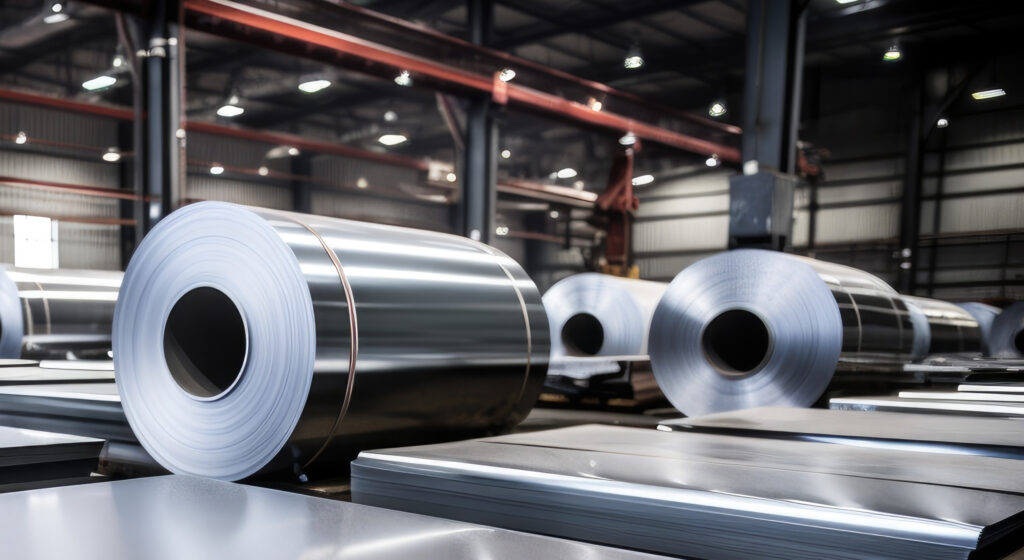- Perspective – May 2025
- Columbus Stainless Advert
- Market Intelligence – Sassda GPS
- Market Intelligence – Fair Trade or Foul Play? The Taxing Truth About Trade Tariffs
- State of the Stainless Nation
- Technical Insight – Stainless Steel and South Africa’s water crossroads
- NDE Advert
- Professional Profile : Pierre Rootman
- Technical Insight – Can mild steel survive where stainless fails?
- Millenium Metals Advert
- Member News – Cronimet
- Market Intelligence – Angola
- Fastenright Advert
- Member News – Coalition Engineering
- Member News – Scientific Engineering
- Sassda News – Western Cape Golf Day
SOUTH AFRICA FACES A DOUBLE THREAT: STEEL JOB LOSSES AND RISING TRADE BARRIERS

South Africa’s steel sector is under pressure. The unresolved uncertainty around the future of ArcelorMittal South Africa’s long-products division continues to cast a shadow over the industry, with the potential loss of up to 100 000 jobs. In tandem, looming US tariffs on South African exports now pose a fresh threat not just to steel, but to critical sectors such as automotive and agriculture. In the latest State of the Stainless Steel Nation Q&A, Sassda Executive Director Michel Basson unpacks the economic risks, the wider implications of global trade politics, and the limited options South Africa has on the table…
Why are US tariffs particularly significant for South Africa at this time?
The proposed 25% tariff on South African exports to the US could hit the economy at a sensitive time. The automotive industry, one of South Africa’s key exporters, is particularly exposed, as it relies heavily on the AGOA trade agreement to access the US market. If those benefits are eroded, a major chunk of foreign revenue could vanish. Agriculture is also at risk, especially the citrus sector, where finding alternative markets is complicated by the logistics of exporting perishable goods. What’s at stake isn’t just trade volume, it’s jobs, economic momentum, and long-term investor confidence.
How would this affect the overall economy?
Estimates suggest the damage could be between 0.3% and 1.3% of GDP. In a country where the economy is expected to grow by just 1.5% in 2025, even the lower estimate would wipe out a third of that growth. South Africa needs at least 4% growth to generate meaningful employment, so any loss at this scale is not just a setback, it’s a red flag for deeper structural pain. Beyond immediate job losses, the ripple effects would slow recovery, reduce investor appetite, and weaken industrial output.
Can South Africa negotiate a way out of this situation?
Not easily. South Africa has limited leverage in negotiations with the US. It’s a small contributor to US imports and, diplomatically, its alignment with global powers like Russia and China complicates things further. Trade diplomacy is driven by relationships, and right now, South Africa hasn’t prioritised political ties with the US in a way that could help defuse the tension. Diversifying trade partnerships could help in the long run, especially through BRICS or the African Continental Free Trade Agreement, but those are not fast-acting solutions.
What’s the current outlook for the stainless steel industry specifically?
The stainless steel sector will feel the impact through its links to the automotive market, especially in products like exhaust systems and catalytic converters. While the local stainless steel sector saw over 20% growth in apparent domestic consumption 2024 - i.e. the stainless steel used by the local value adding sector - Sassda doesn’t expect the same in 2025. Still, the industry is starting from a strong position, and that foundation should help it weather some of the turbulence, at least in the short term.
What role does the ArcelorMittal uncertainty still play in the steel sector’s risk profile?
The unresolved future of ArcelorMittal South Africa’s long-products division remains a major source of instability. The potential loss of up to 100 000 jobs is a looming threat that compounds the challenges facing the sector. Until a clear decision is made, businesses across the steel value chain are holding back investment, and confidence remains low. It’s a slow bleed not a shock, but the damage could be long-term if strategic clarity isn’t restored soon.
What is the current status of ArcelorMittal South Africa’s long-products division?
As of May 2025, ArcelorMittal South Africa has postponed the planned closure of its long-products division until at least August 31, 2025. This decision follows a R1.683 billion ($91.5-Million) capital injection from the state-owned Industrial Development Corporation (IDC). The reprieve allows the company to continue producing essential materials, such as fencing, rail, rods, and bars, used in construction, mining, and manufacturing sectors. Approximately 3 500 jobs have been preserved during this period. During the deferral, ArcelorMittal South Africa, in collaboration with the IDC and the Department of Trade, Industry and Competition, will assess the long-term viability of the division. Key issues under review include high operational costs, competition from mini-mills, and challenges in the logistics infrastructure.
What do local economic indicators suggest about the months ahead?
Recent data points to growing strain. The Absa Purchasing Managers Index (PMI) dropped to 44.7 in April 2025, marking six straight months of contraction. Businesses report weak demand, continued uncertainty, and pessimism about future conditions. The employment index is also down, reflecting layoffs as production slows. Meanwhile, rising input costs driven by currency fluctuations and global supply shifts are squeezing margins. Even inventory levels are unstable, with some manufacturers stockpiling in anticipation of further trade shocks.
What is being done to protect the local industry?
Sassda is actively working with the Department of Trade, Industry and Competition (dtic) to review imported items and determine where tariffs or duties could be applied to protect local manufacturers. But applying trade barriers is complex as it requires careful selection of products (via HS codes) and public consultation. While these tools may help rebalance trade, they’re no quick fix. The process demands strong coordination between government and industry, and clear communication to avoid unintended consequences.

